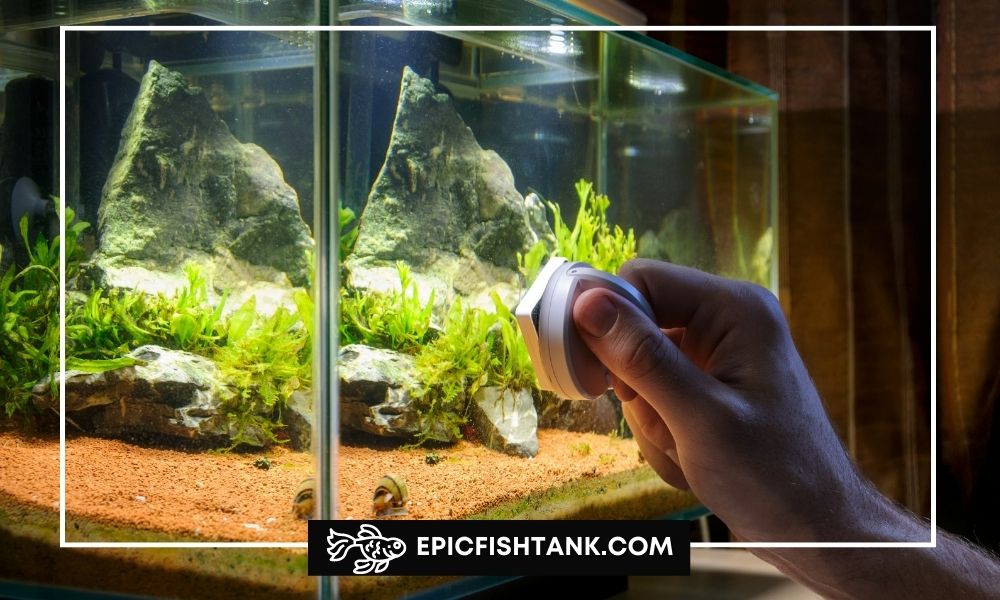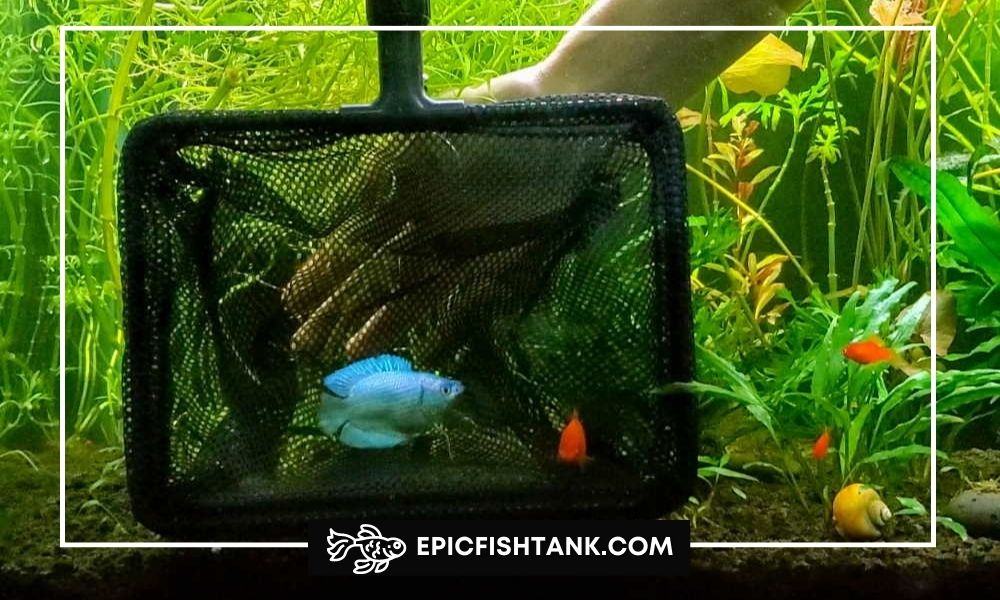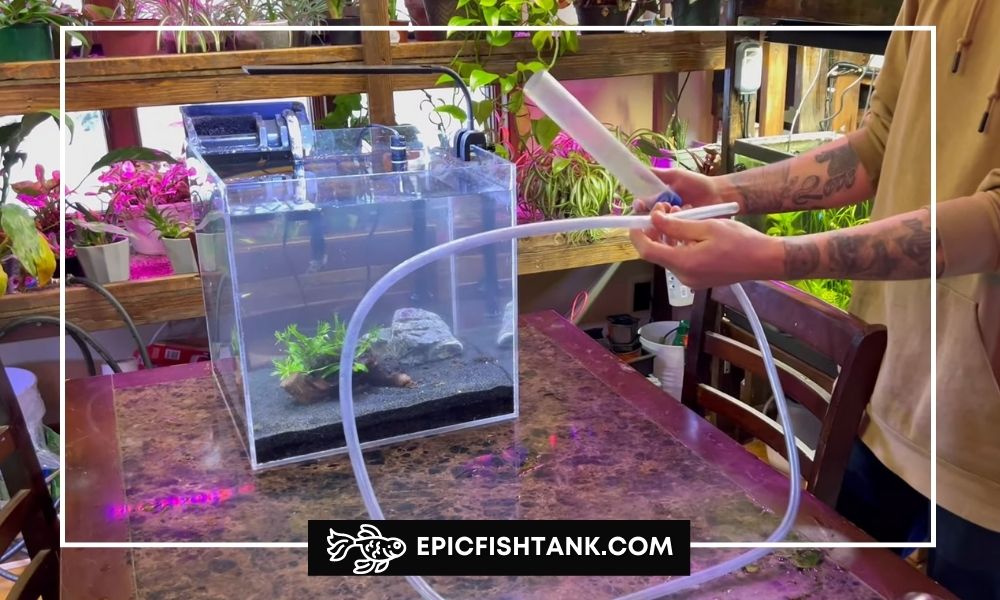At-Home Care: How To Clean A Fish Tank

Have you ever wondered how to keep a fish tank looking its best? Cleaning a fish tank isn’t as hard as it seems! Here at Epicfishtank, we have tips and tricks on the most effective ways to remove algae, dirt, gunk, and more from your aquarium.
We also provide instructions on how to properly change the filter media in your filter system so it continues working efficiently without affecting water quality. All of our advice is easy-to-understand and even easier to implement! Check out our helpful blog post now for all of your fish tank cleaning needs!
5 Benefits of Regularly Cleaning Your Fish Tank
Here’s a list summarizing the purpose or goals of cleaning a fish tank:
- Maintain a healthy and safe environment for the fish and other aquatic organisms living in the tank.
- Remove excess waste, debris, and harmful chemicals that can accumulate in the tank over time.
- Prevent poor water quality, which can lead to health issues for the aquatic inhabitants.
- Enhance the visual appeal of the aquarium and create a more enjoyable and aesthetically pleasing environment.
- Promote the longevity and well-being of the fish and other aquatic organisms in the tank.
Essential Equipment for Aquarium Cleaning
Regular aquarium maintenance not only keeps your fish healthy, but also prolongs the lifespan of your aquarium.
To make your cleaning process effective and efficient, it’s important to have the right tools and equipment on hand. Here are some essential tools you need for maintaining a healthy aquarium environment:
| Equipment | Purpose |
| Aquarium water test kit | To test the water parameters in the fish tank |
| Fish net | To catch and remove fish from the tank during cleaning |
| Bucket | For holding dirty tank water during water changes |
| Algae scraper | For cleaning algae off the glass or acrylic surfaces of the tank |
| Algae scraper blade | Attachment for algae scraper used for cleaning glass or acrylic |
| Toothbrush | To clean algae off decorations or plants in the tank |
| Scissors | To prune plants in the tank |
| Dechlorinator | Water conditioner used to remove chlorine and other harmful agents |
| Glass cleaner | For cleaning the exterior of the tank |
| Towel | To wipe up water spills during cleaning |
| Glass-cleaning cloth | To clean the glass or acrylic surfaces of the tank |
| Aquarium siphon/gravel vacuum | For removing debris and waste from the substrate during water changes |
The Basics of Fish-less Tank Cleaning
Step-by-step instructions on how to clean a freshwater fish tank:
Step 1: Prepare for Cleaning
Before starting the cleaning process, turn off all the electrical devices connected to the fish tank, including the filter, heater, and light. This step is important to prevent any accidents while cleaning. Also, ensure that the water in the tank is at least room temperature or slightly warmer to avoid any temperature shock to the fish.
Step 2: Remove Fish

Using a fish net, carefully remove the fish from the tank and place them in a separate container with some tank water. This step will ensure the fish’s safety and prevent them from getting hurt during the cleaning process.
There are several reasons why removing fish using a fish net is important:
- Preventing injury: During the cleaning process, there is a risk of injuring the fish with cleaning tools or accidentally bumping into them. Removing the fish from the tank with a fish net helps prevent accidental injury.
- Reducing stress: Cleaning a fish tank can be a stressful experience for the fish, especially if they are exposed to sudden changes in water temperature or quality. By removing the fish from the tank using a fish net, you can help reduce their stress levels.
- Making cleaning easier: Removing the fish from the tank makes it easier to clean the tank thoroughly without having to worry about accidentally harming or disturbing the fish.
- Preventing contamination: Removing the fish from the tank prevents them from swimming around in the dirty water during the cleaning process, which can cause them to ingest harmful substances or bacteria.
Step 3: Remove Decorations and Plants
Remove all decorations and plants from the tank and place them in a separate container. Use a toothbrush to gently scrub away any algae or debris from the decorations and plants. Trim any dead or decaying leaves from the plants using scissors.
There are several reasons why this step is necessary:
- Access to all areas of the tank: By removing decorations and plants, you can access all areas of the tank, including those that are normally hidden or difficult to reach. This makes it easier to clean the tank thoroughly and ensure that no areas are missed.
- Avoid damaging plants and decorations: Certain cleaning agents and tools can be harmful to plants and decorations in the tank. By removing them before cleaning, you can avoid any potential damage.
- Check for damage or wear: When you remove decorations and plants, you can inspect them for any damage or wear that may need to be addressed. This can include broken or sharp edges on decorations that could injure fish, or wilted or damaged plants that may need to be removed.
Step 4: Clean the Glass
Using an algae scraper, clean the inside walls of the tank. For glass tanks, use the scraper blade attachment to remove any stubborn algae or debris. For acrylic tanks, use a specialized algae scraper that won’t scratch the surface. Once the cleaning is complete, use a glass cleaner and glass-cleaning cloth or paper towel to clean the exterior of the tank.
A “Magic” Way To Clean Your Aquarium Glass
The video is about the use of a melamine sponge to clean the glass of an aquarium. The sponge is effective against green spot algae, which is difficult to remove with traditional cleaning materials.
The sponge is made of an open-cell foam that hardens to a level close to glass but stays soft and pliable. The micro-pores of the sponge grab and hold onto everything wiped down with it. It is best to use a gentle, circular motion when cleaning with the sponge, and it will not scratch or damage the glass.
Step 5: Clean the Gravel

Use an aquarium siphon or gravel vacuum to remove debris and waste from the substrate. The siphon or vacuum should be placed in the gravel and the dirty water should be collected in a bucket. It is recommended to remove about 25% of the tank water during this process.
Step 6: Clean the Filter
Remove the filter and clean it according to the manufacturer’s instructions. Rinse the filter media in the dirty tank water that was collected in the bucket. Avoid using tap water as it may contain chlorine or other harmful agents. Replace any worn or damaged filter media.
Step 7: Refill the Tank
Add dechlorinator or water conditioner to the new water before refilling the tank. This will remove any harmful agents that may be present in the tap water. Refill the tank with clean water and return the decorations and plants to their original positions.
There are several reasons why this step is important:
- Replacing dirty water: By refilling the tank with clean water, you are replacing the dirty water that was removed during the cleaning process. This helps maintain a healthy and clear environment for your fish.
- Restoring water clarity: Over time, fish tanks can become cloudy or discolored due to a buildup of organic matter, excess nutrients, or algae. Refilling the tank with clean water can help restore water clarity and improve the overall appearance of the tank.
- Balancing water chemistry: When refilling the tank, it’s important to use water that has been treated to remove chlorine and other harmful chemicals. This helps balance the water chemistry and creates a safe environment for your fish.
- Providing fresh oxygen: Clean water contains fresh oxygen that is important for the health of your fish. Refilling the tank helps ensure that your fish have access to plenty of oxygen and can breathe easily.
Also Read: How to Change Water in Fish Tank: A Step-by-Step Guide
Step 8: Return the Fish
After the cleaning is complete and your fish have returned to their home, make sure to observe them for a few days to make sure they settle back in.
Additional Steps: Prune Aquatic Plants
It is important to be careful during this process so as not to disrupt or harm the fish. Before pruning aquatic plants, make sure to clean the fish tank to remove any dirt or debris that could cause harm.
Then, proceed with removing dead parts of aquatic plants and trimming back overgrown areas that may be crowding other aquatic plants or blocking out light from reaching them.
Make sure not to create too much flow with your trimming movements, as this can harm the aquatic plant structure and cause distress to the fish in the process. By taking proper precautions throughout this process, you will have healthy aquatic plants and happy fish!
There are several reasons why pruning plants is necessary during the cleaning process:
- Promote plant growth: Regular pruning helps promote healthy plant growth and prevents the plants from becoming too crowded or overgrown. This ensures that the plants can continue to provide oxygen and absorb excess nutrients in the tank.
- Prevent decay: Dead or dying leaves or stems can contribute to decaying organic matter in the tank, which can cause imbalances in the water chemistry and harm your fish. Pruning these parts of the plant helps prevent decay and keeps the tank clean and healthy.
- Maintain tank aesthetics: Overgrown or unkempt plants can detract from the overall appearance of the tank. Pruning helps maintain the aesthetics of the tank and ensures that it looks clean and attractive.
- Provide hiding places: Pruning plants can create hiding places for fish and other aquatic life in the tank, which can reduce stress and provide a more natural environment.
Easiest way to clean a fish tank without removing fish
The video is about cleaning fish tanks without removing the fish. The speaker shows her four fish tanks, including a 55-gallon tank, and explains her cleaning routine, which involves using conditioning drops, a siphon, an algae scraper, and a bucket.
She also mentions that she adds water to the tanks throughout the month and cleans them once a month. The speaker also briefly talks about her pets, including her bettas and mollies.
Comparison between Fish-less Tank Cleaning and Tank Cleaning with Fish
| Criteria | Fish-less Tank Cleaning | Tank Cleaning with Fish |
|---|---|---|
| Presence of fish | No fish are present during the process | Fish are present during the process |
| Effectiveness in cleaning | More effective for getting rid of algae and other unwanted debris | May require more attention and effort to remove all debris and clean thoroughly |
| Equipment required | Specialized equipment needed for proper sanitation and dechlorination of water | No additional equipment required for sanitation since it is taken care of by the fish’s presence |
| Pet stress level | No stress on pets as they are not present during the process | Pets may be stressed due to the disturbance in their familiar environment |
| Time efficiency | Generally takes less time if done right as there isn’t anything else living in there that needs special consideration or attention | May require more time and attention to ensure that the fish are not harmed during the cleaning process |
| Cost efficiency | May end up being more costly than maintaining with fish if done incorrectly or haphazardly, since expensive equipment may be required for proper sanitation | May be more cost-effective in the long run, as there is no additional equipment required for sanitation and dechlorination |
| Overall Health of Pet Fish | Effective in removing debris and algae, which can contribute to the overall health of the fish | May cause stress to the fish, which could have negative impacts on their health if not properly managed |
EpicFishTank Note:
When deciding which method is best for cleaning your aquarium, it is important to consider various factors such as cost, time, and overall health of your pet fish.
Both methods have their own advantages and disadvantages, and it is up to the individual to determine which method works best for their situation. With proper research and careful consideration, you can keep your aquarium clean and your pet fish healthy.
Maintenance Tasks for a Healthy Fish Tank
Prior to delving into the methods for cleaning your fish tank, it is essential to address the critical daily and weekly maintenance tasks that are necessary to maintain a healthy aquatic environment in your tank between cleanings.
Here is a table summarizing the daily and weekly maintenance tasks that are important to maintain a healthy fish tank:
| Maintenance Task | Frequency | Importance |
| Check water temperature | Daily | Essential for fish health and comfort |
| Check filter system | Weekly | Ensures proper water circulation and filtration |
| Monitor water parameters (pH, ammonia, nitrite, nitrate) | Weekly | Helps prevent water toxicity and fish stress |
| Perform partial water changes | Weekly | Removes excess waste and replenishes essential minerals |
| Scrub algae off tank walls and decor | Weekly | Promotes a clean and visually appealing tank environment |
| Check fish for signs of illness or stress | Daily | Allows for prompt treatment and prevention of potential health issues |
| Feed fish appropriate amount of food | Daily | Prevents overfeeding and excess waste buildup |
| Remove uneaten food and debris from tank | Daily | Prevents excess waste buildup and maintains water quality |
EpicFishTank Note:
By consistently performing these daily and weekly maintenance tasks, you can help ensure that your fish tank remains a healthy and thriving environment for your aquatic pets.
Final Words
Cleaning your fish tank doesn’t have to be complicated, and it’s an important part of keeping your fish healthy and happy.
By following these steps you can keep your fish tank clean and make sure your fish receive the best care possible. Remember to change the water regularly, use a good filter, vacuum the gravel, do regular partial water changes, and monitor the levels of ammonia and nitrates in the tank.
References
- PIAA | How to clean a fish tank
Time for a coffee break! With your support, We can keep working hard and creating fantastic content. #let's make it happen!
Author
Reza is a digital marketer and an avid freshwater aquarist. He's been keeping fish tanks for more than 10 years and has always been fascinated by the delicate balance of life in water.
Reza loves to share his knowledge about both digital marketing and fishkeeping with others, and he is always happy to help new aquarists get started in this rewarding hobby.
Wibisono is a freshwater fish breeder who raises and breeds different species of ornamental fish like betta, guppy, flowerhorn, and goldfish. He has been in the business since 2018 and exports his fish to different countries. He is committed to providing high-quality and healthy fish to his customers.

Leave a Reply